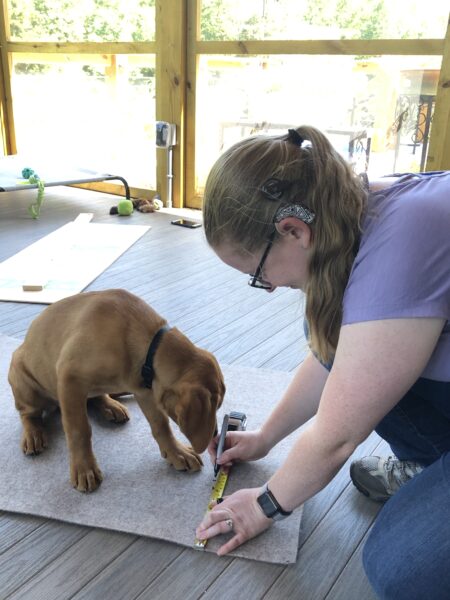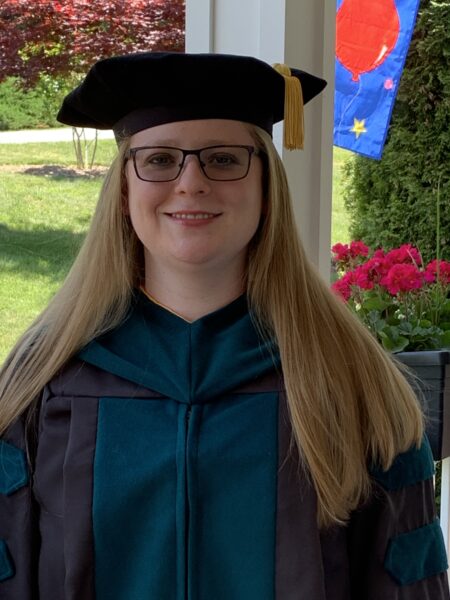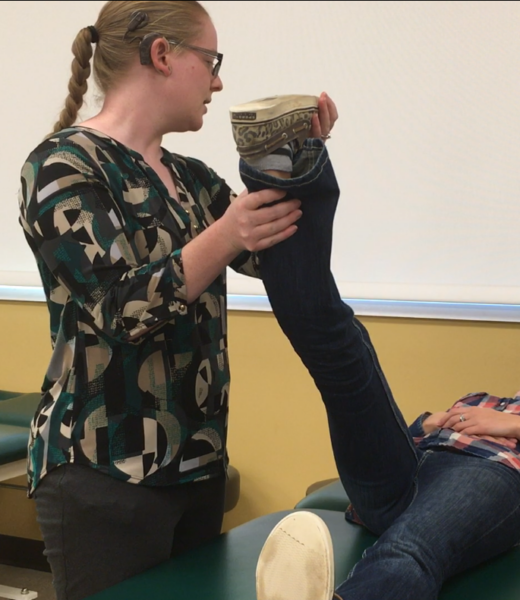Laura has lived nearly her entire life with hearing loss after she was diagnosed with Waardenburg syndrome. While attending college, she learned that she was a cochlear implant candidate, which set her up for her future career. After receiving bilateral cochlear implants, Laura pursued a doctorate degree in physical therapy. More on her story here:
“I was born with Waardenburg syndrome, which caused congenital hearing loss for me. I was diagnosed with hearing loss at 6 weeks of age and began to wear hearing aids shortly after. This was in the days before hearing screening were routine for infants and my parents fought to have my hearing tested. The nurses who complete the hearing screenings said I was too young and needed to wait for more accurate results.
My hearing loss went from moderate-to-severe at birth, to profound by the time I reached my early 20s. My senior year of college at Rochester Institute of Technology (RIT) was the toughest year yet, not only due to the courses I was taking, but my hearing had reached the point where a one-on-one conversation in a quiet environment required a good deal of lip reading and asking for repetition.
Luckily RIT was able to provide captioning services for all my classes without fuss. It was November of my senior year when I received a cochlear implant (CI) in my left ear and due to my class schedule it was 5 weeks before I was able to get activated.
 Finding the best solution for my lifestyle
Finding the best solution for my lifestyle
I chose Cochlear for my first implant after doing some research and comparing brands. I felt Cochlear just fit with my lifestyle the best! The design style of the Nucleus® 5 Sound Processor versus the other brands wow-ed me.
Early on in my hearing journey I knew I made the right choice in getting implanted. My audiologist stuck me in the dreaded sound booth and tested my word comprehension at six days post activation. I scored 99% on sentences in quiet. Sure, people still sounded like monotone, computerized voices but I was able to understand them!
Due to my long history of hearing loss, it took me approximately six months to stop second guessing what people said and just believe what my ears were hearing! Saying ‘what’ is a very hard habit to break! It took a while, but by the six month mark people sounded like themselves and environmental noises were very recognizable.
Once my hearing with my sound processor was well on track to becoming the best hearing I’d had in my entire life, I felt lopsided with my hearing. With a CI in my left ear and hearing aid in my right ear, I was always turning around in circles thinking someone was calling me from my left when really they were on my right. This lopsidedness prompted me to get evaluated for my right ear.
 Bilateral cochlear implants
Bilateral cochlear implants
2.5 years after getting my first cochlear implant, I went and did it again to become bilateral. This was the second-best thing I did for myself; the first being the first CI. Activation for my right ear wasn’t the magical improvement to my hearing I had with my first one, however it was still a great improvement!
The best way I can compare my hearing improvement is this: hearing aids with profound hearing loss is like watching something on those old grainy analogue TVs. By getting my first CI I was able to ‘upgrade’ that TV to a digital TV, however, it was one of those with only standard definition.
Going bilateral allowed me to ‘upgrade’ my hearing again and this time I got high definition. Having one CI definitely improved my life and access to the hearing world, going bilateral allowed me the luxury of being able to not only hear people in noise but understand them in noise.
 Exploring what I want to do with my life
Exploring what I want to do with my life
Since graduating from RIT and going bilateral, I began exploring what I wanted to do with my life. I became an EMT and worked for a couple years on an ambulance. Through use of my Nucleus 6 Sound Processors and Mini Microphone I was able to connect to an electronic stethoscope and function in my job just as well as my peers. There were times I was in super noisy environments and was able to get vital signs from my patients, whereas my hearing coworkers had difficulty.
I learned that being an EMT wasn’t something I felt I could do in the long run, so I kept exploring my options. In 2018 I returned to school to become a physical therapist at Mary Baldwin University. Having bilateral cochlear implants allowed me the luxury I didn’t have for my undergraduate education: no accommodations needed! I survived three years of graduate classes and clinical training without the need for captioning like I did in my earlier education.
When COVID broke out and my classes went online it wasn’t a big deal for me. I just plugged my TV Streamer into my computer and was able to hear beautifully, even though many of my classmates were using not so great laptop mics to talk.
Where I am at now in my journey
In 2021, still at the height of COVID, I graduated with my Doctor of Physical Therapy degree and moved across the country to begin working in my field. Wearing masks was and still is a big part of daily life working in the medical field. I am thankful my sound processors provide the ability to understand people wearing masks in a noisy environment. This is not something I would have been able to do in my pre-CI days.
I am now 11 years and eight and a half years out of activation and have continued to enjoy my CI hearing. One audiologist even commended me for my ability to hear in noise, stating that the only other people she has seen do as well as I have were implanted as babies/young children1. I am very thankful to my parents and early childhood teachers for pushing hard for spoken language and speech quality. The vast majority of people I meet nowadays have no clue that I am in fact deaf.
Interesting fact: due to the amazing success I have had with my CIs, I have pretty much lost the ability to lip read! I spent over 20 years lip reading and my 10 years of CI hearing has mostly erased that ability. I’m not disappointed though, my CI hearing has far surpassed any hearing aids I ever had.”
If you or someone you know has been diagnosed with Waardenburg syndrome, cochlear implants may be a solution! Learn about these devices today!
- In the US, the cochlear implant system is intended for use in children 9 to 24 months of age who have bilateral profound sensorineural deafness and demonstrate limited benefit from appropriate binaural hearing aids. Children two years of age or older may demonstrate severe to profound hearing loss bilaterally. In Canada, the cochlear implant system is intended for use in children 12 to 24 months of age who have bilateral profound sensorineural deafness and demonstrate limited benefit from appropriate binaural hearing aids. Children two years of age or older may demonstrate severe to profound hearing loss bilaterally.